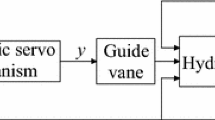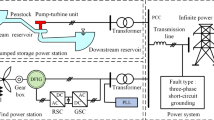Abstract
Hydraulic impedance, as an efficient frequency-domain analysis alternative, has been widely utilized in hydraulic transient analysis for decades. Since the mathematical expressions of hydraulic systems with complicated pipe networks are usually rather complex, it is difficult for the traditional continuous impedance method to obtain the analytical solutions to the system’s frequency responses directly. Therefore, an equivalent circuit modeling-based discrete impedance method is proposed to mathematically express the hydraulic systems of a pumped storage plant system with complicated pipe networks. Through drawing an analogy between various hydraulic facilities and different types of electrical circuits, the equivalent circuit topology of any hydraulic system can be obtained according to the circuit theory in electrical engineering. The oscillation analysis of the pumped-storage power plant is conducted, and influences of the pump-turbine impedance on the system’s oscillation characteristics have been discussed.
You have full access to this open access chapter, Download conference paper PDF
Similar content being viewed by others
Keywords
1 Introduction
The pumped-storage power plant is known as a multi-physics coupling system [1] and usually has a very complicated flow passage layout, so the investigation of the hydraulic features of pumped-storage systems is of great importance. Over the past decades, researchers have proposed different mathematical models of pumped-storage systems for better hydraulic description, and the mathematical analysis schemes are divided into two categories, i.e., time-domain models and frequency-domain models [2].
Time-domain models excel in simulating the time evolutions of the system states, e.g., the rotation speed, the head and the discharge [3]. Frequency-domain methods, such as the well-known transfer matrix [4] and hydraulic impedance [5], were extensively adopted in the stability criterion and the oscillation analysis of hydraulic systems. The hydraulic impedance [6] can explicitly express the relationship between head and discharge in complex domain. Existing literature has reported its applications in many practical water conveyance scenarios [7,8,9].
This paper introduces an equivalent circuit model-based discrete impedance method that can be applied to the complex frequency-domain analysis of pumped storage systems. The hydraulic transients in pipes are analogized with the electromagnetic characteristics in transmission lines. For a complex pumped storage plant system, the overall circuit topology can be obtained by combining the equivalent circuits of different hydraulic components according to the system structural layout. Oscillation analysis was performed in a pumped-storage power plant with a complex flow passage structure by applying the proposed discrete impedance model.
2 Methodology of the Equivalent Circuit Model
The Saint–Venant equations of the pressurized pipe [10, 11] are given as Eq. (1)
where, H and Q denote the pressurized head and discharge, respectively. nc, \(R_{a}\) and A represent the friction factor, the hydraulic radius and the cross-sectional flowing area of the pipe, respectively.
Since the value of wave propagation velocity a is bigger than that of flow velocity v, \(v\frac{\partial H}{{\partial x}}\) is often ignored [11]. The hydraulic dynamics of the pipe can be modelled as a T-shaped equivalent circuit shown in Fig. 1, where \(R_{e}\), \(L_{e}\), \(C_{e}\) are the circuit resistance, inductance and capacitance per unit length, respectively.
The equivalent resistance, inductance, and capacitance parameters can be obtained as \(R_{e} = \frac{{n_{c}^{2} \left| Q \right|}}{{R^{4/3} A^{2} }} - \frac{{S_{0} }}{Q}{ + }\frac{1}{{gA^{2} }}\frac{\partial Q}{{\partial x}}\), \(L_{e} = \frac{1}{gA}\), \(C_{e} = \frac{gA}{{a^{2} }}\).
where, the partial differential term \(\frac{1}{{gA^{2} }}\frac{\partial Q}{{\partial x}}\) corresponds to \(v\frac{\partial h}{{\partial x}}\) in Eq. (2).
3 System Plant Introduction and its Modelling
A pumped-storage power plant with a complex conduit system was taken as a case study. The flow passage comprises of a diversion tunnel, an upstream surge tank, a penstock, a volute, a draft tube and extension, a tailrace surge tank, and a tailrace tunnel. The structural schematic of the hydraulic system is illustrated in Fig. 2.
According to the equivalent circuit modeling theory, the overall equivalent circuit topology of the flow passage of the pumped-storage plant is shown in Fig. 3.
4 Simulation Result Analyses
The decay coefficients and eigen frequencies of the first ten orders of oscillation in free oscillation analysis with the proposed discrete model and the traditional continuous model are listed in Table 1. It shows that ECM can obtain very similar complex eigen frequency results to those of the traditional continuous impedance model. The modeling errors between the two models are quite small for low-frequency responses and gradually increase for higher frequency responses. The oscillation frequencies of the first two orders of oscillation are much lower than those of others. Compared with the classic theoretical oscillation frequencies of the surge tanks calculated by the equations in [10], the first two orders of oscillation are believed to coincide with the oscillation modes of the tailrace surge tank and upstream surge tank, respectively. While the 3rd - 10th order oscillations correspond to the os cillation modes of the system pipelines.
The change regulations of the decay coefficients of the 3rd- to 10th-order oscillations are depicted in Fig. 4. The decay coefficients of eight oscillation orders share the same variation trends and decrease at different rates as pump-turbine impedance increases. The 3rd-order oscillation possesses the fastest decreasing rate, while the 5th-order oscillation possesses the slowest. The decay coefficients are positive when ZT < 0 and negative when ZT > 0. When ZT = 0, the decay coefficient equals zero, which means the oscillation pattern at this condition is a constant amplitude oscillation.
To further investigate the variation trend of the eigen frequency in each order of oscillation, the precise variation trends of the 3rd- to 10th- order of oscillation are displayed in Fig. 5 (a)–(h), respectively. It shows that the eigen frequencies of most oscillations vary along with the change of the pump-turbine impedance though the oscillation amplitudes are very small. Among the eight orders of oscillation, the frequencies of the 3rd-, 4th-, 9th-, and 10th- orders of oscillation decrease as the absolute value of the pump-turbine impedance increases, and the frequencies of the 6th-, 7th-, and 8th- orders of oscillation increase as the absolute value of the pump-turbine impedance increases. the frequency of the 5th- order oscillation remains constant as the pump-turbine impedance varies.
5 Conclusions
This work introduced an equivalent circuit modeling (ECM)-based discrete hydraulic impedance method in complex frequency-domain analysis of pumped storage systems. The proposed ECM-based impedance method can achieve satisfactory modeling accuracy. In the oscillation analysis of the pumped-storage power plant, numerical results showed that there exists a close relationship between the value of the pump-turbine impedance and the decay coefficients of the different orders of oscillation. However, the pump-turbine impedance can hardly affect the system’s eigen frequencies.
References
Feng C, Zheng Y, Li C, Mai Z, Wu W, Chen H (2021) Cost advantage of adjustable-speed pumped storage unit for daily operation in distributed hybrid system. Renew Energ 176:1–10
Yang J (2018) Applied fluid transients. Science Press, Beijing. (in Chinese)
Zheng Y, Chen Q, Yan D, Liu W (2020) A two-stage numerical simulation framework for pumped-storage energy system. Energy Conv Manag 210:112676
Vitkovsky JP, Lee PJ, Zecchin AC, Simpson AR, Lambert MF (2011) Head- and flow-based formulations for frequency domain analysis of fluid transients in arbitrary pipe networks. J Hydraul Eng 137:556–568
Kim SH (2011) Dynamic memory computation of impedance matrix method. J Hydraul Eng 137:122–128
Suo L, Wylie EB (1989) Impulse response method for frequency-dependent pipeline transients. J Fluids Eng ASME 111:478–483
Gong JZ, Lambert MF, Simpson AR, Zecchin AC (2013) Single-event leak detection in pipeline using first three resonant responses. J Hydraul Eng 139:645–655
Duan HF, Lee PJ, Ghidaoui MS, Tung YK (2011) Extended blockage detection in pipelines by using the system frequency response analysis. J Water Res Plan Man 138:55–62
Kim SH, Choi D (2022) Dimensionless impedance method for general design of surge tank in simple pipeline systems. Energies 15:3603
Chaudhry MH (2014) Applied hydraulic transients. Springer, London
Zhao Z, Yang J, Yang W, Hu J, Chen M (2019) A coordinated optimization framework for flexible operation of pumped storage hydropower system: nonlinear modeling, strategy optimization and decision making. Energy Conv Manag 194:75–93
Acknowledgements
Authors wish to acknowledge the financial support from National Natural Science Foundation of China (grant number: 52009096) and China Postdoctoral Science Foundation (grant number: 2022T150498)
Author information
Authors and Affiliations
Corresponding author
Editor information
Editors and Affiliations
Rights and permissions
Open Access This chapter is licensed under the terms of the Creative Commons Attribution 4.0 International License (http://creativecommons.org/licenses/by/4.0/), which permits use, sharing, adaptation, distribution and reproduction in any medium or format, as long as you give appropriate credit to the original author(s) and the source, provide a link to the Creative Commons license and indicate if changes were made.
The images or other third party material in this chapter are included in the chapter's Creative Commons license, unless indicated otherwise in a credit line to the material. If material is not included in the chapter's Creative Commons license and your intended use is not permitted by statutory regulation or exceeds the permitted use, you will need to obtain permission directly from the copyright holder.
Copyright information
© 2023 The Author(s)
About this paper
Cite this paper
Zheng, Y., Liu, W., Zhou, X., Liu, W., Chen, Q. (2023). Complex Frequency-Domain Oscillation Analysis of the Pumped-Storage Systems. In: Feng, G. (eds) Proceedings of the 9th International Conference on Civil Engineering. ICCE 2022. Lecture Notes in Civil Engineering, vol 327. Springer, Singapore. https://doi.org/10.1007/978-981-99-2532-2_37
Download citation
DOI: https://doi.org/10.1007/978-981-99-2532-2_37
Published:
Publisher Name: Springer, Singapore
Print ISBN: 978-981-99-2531-5
Online ISBN: 978-981-99-2532-2
eBook Packages: EngineeringEngineering (R0)









